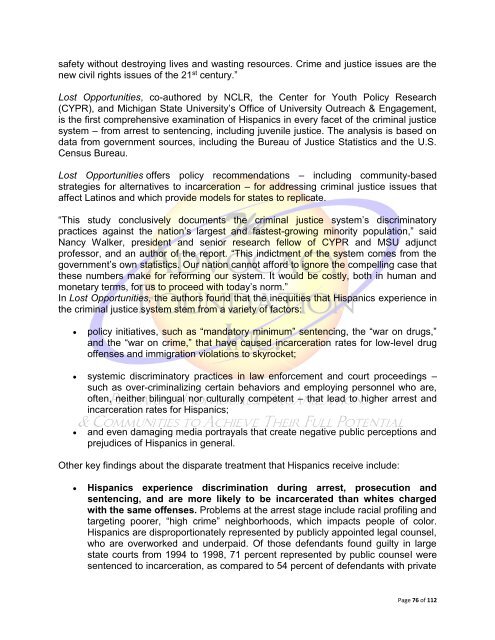Latino and Hispanic Youth in the Juvenile Justice System
Latino and Hispanic Youth in the Juvenile Justice System
Latino and Hispanic Youth in the Juvenile Justice System
Create successful ePaper yourself
Turn your PDF publications into a flip-book with our unique Google optimized e-Paper software.
safety without destroy<strong>in</strong>g lives <strong>and</strong> wast<strong>in</strong>g resources. Crime <strong>and</strong> justice issues are <strong>the</strong><br />
new civil rights issues of <strong>the</strong> 21 st century.”<br />
Lost Opportunities, co-authored by NCLR, <strong>the</strong> Center for <strong>Youth</strong> Policy Research<br />
(CYPR), <strong>and</strong> Michigan State University’s Office of University Outreach & Engagement,<br />
is <strong>the</strong> first comprehensive exam<strong>in</strong>ation of <strong>Hispanic</strong>s <strong>in</strong> every facet of <strong>the</strong> crim<strong>in</strong>al justice<br />
system – from arrest to sentenc<strong>in</strong>g, <strong>in</strong>clud<strong>in</strong>g juvenile justice. The analysis is based on<br />
data from government sources, <strong>in</strong>clud<strong>in</strong>g <strong>the</strong> Bureau of <strong>Justice</strong> Statistics <strong>and</strong> <strong>the</strong> U.S.<br />
Census Bureau.<br />
Lost Opportunities offers policy recommendations – <strong>in</strong>clud<strong>in</strong>g community-based<br />
strategies for alternatives to <strong>in</strong>carceration – for address<strong>in</strong>g crim<strong>in</strong>al justice issues that<br />
affect <strong>Lat<strong>in</strong>o</strong>s <strong>and</strong> which provide models for states to replicate.<br />
“This study conclusively documents <strong>the</strong> crim<strong>in</strong>al justice system’s discrim<strong>in</strong>atory<br />
practices aga<strong>in</strong>st <strong>the</strong> nation’s largest <strong>and</strong> fastest-grow<strong>in</strong>g m<strong>in</strong>ority population,” said<br />
Nancy Walker, president <strong>and</strong> senior research fellow of CYPR <strong>and</strong> MSU adjunct<br />
professor, <strong>and</strong> an author of <strong>the</strong> report. “This <strong>in</strong>dictment of <strong>the</strong> system comes from <strong>the</strong><br />
government’s own statistics. Our nation cannot afford to ignore <strong>the</strong> compell<strong>in</strong>g case that<br />
<strong>the</strong>se numbers make for reform<strong>in</strong>g our system. It would be costly, both <strong>in</strong> human <strong>and</strong><br />
monetary terms, for us to proceed with today’s norm.”<br />
In Lost Opportunities, <strong>the</strong> authors found that <strong>the</strong> <strong>in</strong>equities that <strong>Hispanic</strong>s experience <strong>in</strong><br />
<strong>the</strong> crim<strong>in</strong>al justice system stem from a variety of factors:<br />
<br />
policy <strong>in</strong>itiatives, such as “m<strong>and</strong>atory m<strong>in</strong>imum” sentenc<strong>in</strong>g, <strong>the</strong> “war on drugs,”<br />
<strong>and</strong> <strong>the</strong> “war on crime,” that have caused <strong>in</strong>carceration rates for low-level drug<br />
offenses <strong>and</strong> immigration violations to skyrocket;<br />
systemic discrim<strong>in</strong>atory practices <strong>in</strong> law enforcement <strong>and</strong> court proceed<strong>in</strong>gs –<br />
such as over-crim<strong>in</strong>aliz<strong>in</strong>g certa<strong>in</strong> behaviors <strong>and</strong> employ<strong>in</strong>g personnel who are,<br />
often, nei<strong>the</strong>r bil<strong>in</strong>gual nor culturally competent – that lead to higher arrest <strong>and</strong><br />
<strong>in</strong>carceration rates for <strong>Hispanic</strong>s;<br />
<br />
<strong>and</strong> even damag<strong>in</strong>g media portrayals that create negative public perceptions <strong>and</strong><br />
prejudices of <strong>Hispanic</strong>s <strong>in</strong> general.<br />
O<strong>the</strong>r key f<strong>in</strong>d<strong>in</strong>gs about <strong>the</strong> disparate treatment that <strong>Hispanic</strong>s receive <strong>in</strong>clude:<br />
<br />
<strong>Hispanic</strong>s experience discrim<strong>in</strong>ation dur<strong>in</strong>g arrest, prosecution <strong>and</strong><br />
sentenc<strong>in</strong>g, <strong>and</strong> are more likely to be <strong>in</strong>carcerated than whites charged<br />
with <strong>the</strong> same offenses. Problems at <strong>the</strong> arrest stage <strong>in</strong>clude racial profil<strong>in</strong>g <strong>and</strong><br />
target<strong>in</strong>g poorer, “high crime” neighborhoods, which impacts people of color.<br />
<strong>Hispanic</strong>s are disproportionately represented by publicly appo<strong>in</strong>ted legal counsel,<br />
who are overworked <strong>and</strong> underpaid. Of those defendants found guilty <strong>in</strong> large<br />
state courts from 1994 to 1998, 71 percent represented by public counsel were<br />
sentenced to <strong>in</strong>carceration, as compared to 54 percent of defendants with private<br />
Page 76 of 112

















